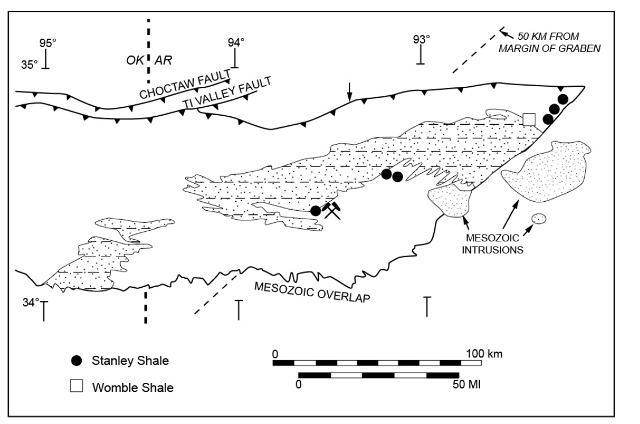Subduction zone cold seep barite - Ouachita Mountains
The Ouachita barite district, in west-central Arkansas, was once the U.S. largest barite producer. Major mining operations were conducted at the Chamberlain Creek mine near Malvern on the east end of the district from 1939 to 1977, producing about 8 million tons of 95 % barite. A new operation was opened at Fancy Hill in Montgomery County in the early 1980s, but never achieved commercial success.
The Ouachita deposits are hosted by lowermost Carboniferous sediments that have been subsequently deformed into a set of imbricate thrust sheets. Diagenetic grade increases from west to east, with vitrinite reflectance values increasing from 0.5 to 5.0 % Ro (Houseknecht and Matthews, 1985).
Mudstone Host
Barite deposits are hosted in the basal beds of the Stanley Formation, the lower-most unit of an extensive Carboniferous accretionary prism exposed in the Ouachita Mountains of west-central Arkansas and southeastern Oklahoma.
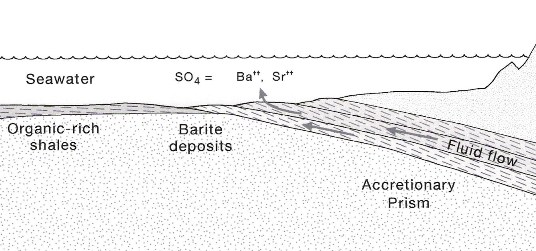
The basin received little clastic supply through the early Paleozoic, as evidenced by the predominance of thin black shales and chert. By the early Mississippian, this basin had begun to close, owing to subduction beneath a volcanic-arc system to the south, and began to be filled by rapidly-deposited clastic sediments derived from the uplifted Appalachians to the east. Barite deposition occurred at this transition.
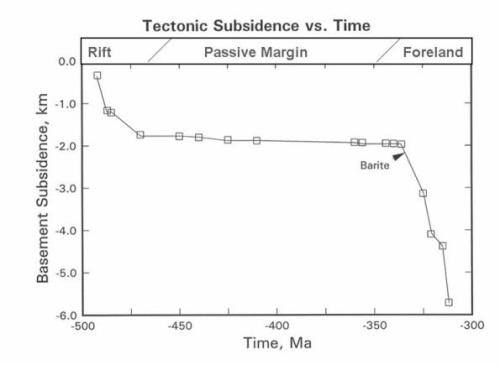
The environment of deposition of the host shales was in a deep, offshore basin. Abundant bioturbation textures in the barite indicate that there was some oxygen in the bottom water. When compared to the USGS black shale standard SDO-1 (data file), the unmineralized Stanley is lower in organic C and is much lower total S, Mo and U, indicating deposition under suboxic rather than euxinic conditions.
Comparing the mineralized section at Fancy Hill to the unmineralized section at Caddo Gap using the isocon method shows that the Fancy Hill shales are somewhat enriched in a variety of organic-associated elements (Mo, Cr, P, Ni, V). Probably the Fancy Hill Stanley had a lower flux of terrigenous clastics, which permitted greater enrichment in elements controlled by surface-water productivity. More extreme enrichment, attributable to hydrothermal activity, is seen for Ba and S, and, to a lesser extent, for Cu. It is noteworthy that there is no hydrothermal component for Pb and Zn in this environment.
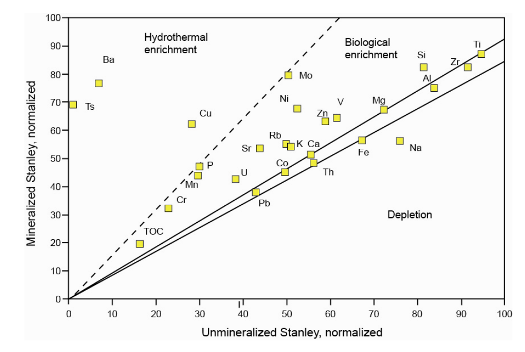
Volcanic Rocks
As would be expected for the 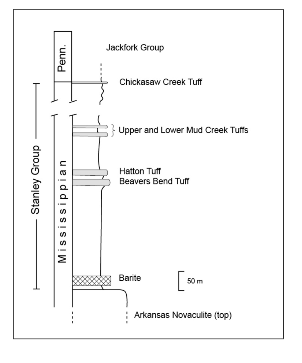 under-riding plate, volcanics are not prominent in the Ouachitas, but several tuff beds are known. Based on the immobile trace elements, the tuff sources can be classified as dacitic to rhyodacitic, and fall on a well-defined trend, with the Beavers Bend and Hatton clustered tightly together and the Mud Creek falling at slightly more felsic values. REE also suggest an evolution of magma composition: Eu/Eu* values are 0.21-0.56 and 0.26-0.42 for the Beavers Bend and Hatton, compared to 0.76-0.84 for the Mud Creek (Loomis et al., 1994). Thus the composition of the ash beds changes with time, but remains well within a field distinct from those of the Red Dog and California Borderland volcanic on the Zr/Ti v Nb/Y diagram.
under-riding plate, volcanics are not prominent in the Ouachitas, but several tuff beds are known. Based on the immobile trace elements, the tuff sources can be classified as dacitic to rhyodacitic, and fall on a well-defined trend, with the Beavers Bend and Hatton clustered tightly together and the Mud Creek falling at slightly more felsic values. REE also suggest an evolution of magma composition: Eu/Eu* values are 0.21-0.56 and 0.26-0.42 for the Beavers Bend and Hatton, compared to 0.76-0.84 for the Mud Creek (Loomis et al., 1994). Thus the composition of the ash beds changes with time, but remains well within a field distinct from those of the Red Dog and California Borderland volcanic on the Zr/Ti v Nb/Y diagram.
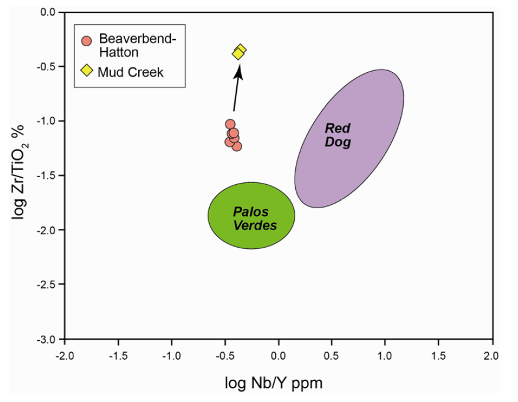
Mineralization
The base of the bedded barites in the western part of the Ouachita barite belt are marked by a pyrite-cemented breccia of Arkansas Novaculite in the footwall of the orebodies. Presumably this is a remnant of the feeder zone for the ore-bearing fluids. The photo below, from the now-covered Dempsy-Cogburn pit, shows the Arkansas Novaculite tilted to about 70 degrees. The overlying barite has been stripped off, exposing the pyrite to weathering and generation of acid mine drainage.
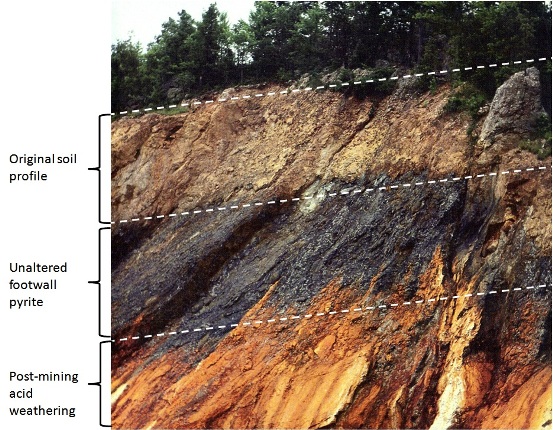
[click for larger image. Free use with attribution.]
Isotopes
Sulfur isotope chemistry of the barites and associated shales (data table) shows a wide range of δ34S values for pyrite, from -30 to +20 per mil, and a much narrower range for barite, from +15 to +20 per mil (excluding one sample at +28). The S in barite is close to Devonian-Mississippian seawater at + 22.5 per mil. The pyrite in samples remote from the mineralization has δ34S values that are almost all negative, averaging -6.4 per mil, whereas pyrite at Fancy Gap is almost all positive and averages +12.9 per mil (data file). Note especially the pyrite-cemented breccia, which gives values between +12 and +13 per mil. These samples probably represent the end-member hydrothermal S. Thus the pyrite in the Stanley Shale at Fancy Gap near the barite ore is overwhelmingly dominated by the hydrothermal source, whereas the pyrite in the Stanley at Caddo Gap is formed from seawater S by bacterial sulfate reduction in an open system close to the sea floor.
Sr isotopes of barite, on the other hand, are somewhat less radiogenic than seawater. 87Sr/86Sr overlaps Early Mississippian seawater (0.70815) but the average is appreciably more radiogenic. Therefore, some Sr was contributed by rocks underlying the deposit as well as from seawater. Ba presumably had the same sources.
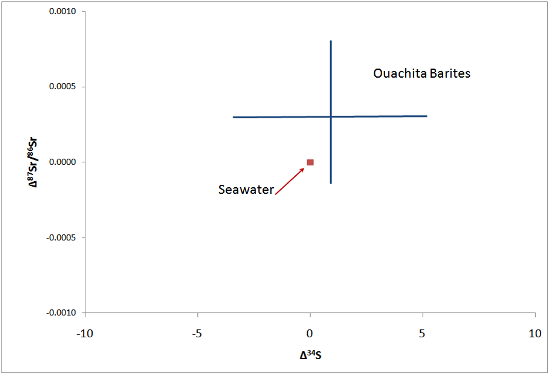
Ore Deposits Home |
Barite references |
Site Map |
|---|
